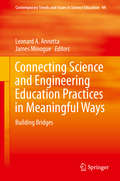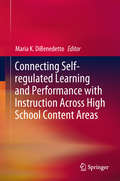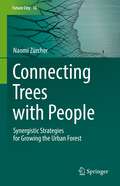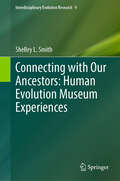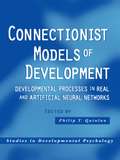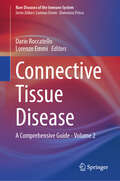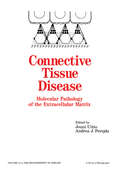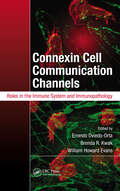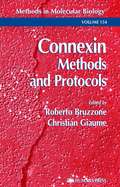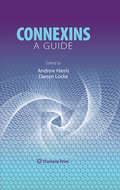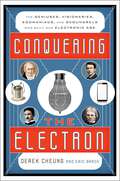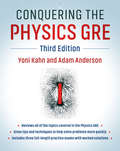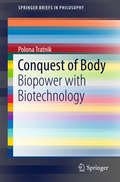- Table View
- List View
Connecting Quarks with the Cosmos: Eleven Science Questions for the New Century
by Committee on the Physics of the UniverseAdvances made by physicists in understanding matter, space, and time and by astronomers in understanding the universe as a whole have closely intertwined the question being asked about the universe at its two extremes--the very large and the very small. This report identifies 11 key questions that have a good chance to be answered in the next decade. It urges that a new research strategy be created that brings to bear the techniques of both astronomy and sub-atomic physics in a cross-disciplinary way to address these questions. The report presents seven recommendations to facilitate the necessary research and development coordination. These recommendations identify key priorities for future scientific projects critical for realizing these scientific opportunities.
Connecting Science Education with Cultural Heritage: Selected Papers from the ESERA 2023 Conference (Contributions from Science Education Research #15)
by Gultekin Cakmakci Mehmet Fatih TasarThis edited volume presents groundbreaking research in science education, focusing on the intersection of science and cultural heritage. Showcasing 23 high-quality studies, it draws from presentations at the 15th Biennial ESERA Conference held in Cappadocia, Türkiye, organized by Hacettepe University, Gazi University, and Nevşehir Hacı Bektaş Veli University. Under the theme "Connecting Science Education with Cultural Heritage," the chapters offer fresh perspectives on advancing science education literature from diverse viewpoints. With contributions spanning continents, this book delivers an exceptional collection of international studies featuring original and rigorous methodologies. Scholars and researchers in science education will find this compilation an invaluable resource, making it a vital addition to academic libraries worldwide.
Connecting Science and Engineering Education Practices in Meaningful Ways: Building Bridges (Contemporary Trends and Issues in Science Education #44)
by Leonard A. Annetta James MinogueThe need for a scientifically literate citizenry, one that is able to think critically and engage productively in the engineering design process, has never been greater. By raising engineering design to the same level as scientific inquiry the Next Generation Science Standards' (NGSS) have signaled their commitment to the integration of engineering design into the fabric of science education. This call has raised many critical questions. . . How well do these new standards represent what actually engineers do? Where do the deep connections among science and engineering practices lie? To what extent can (or even should) science and engineering practices co-exist in formal and informal educational spaces? Which of the core science concepts are best to leverage in the pursuit of coherent and compelling integration of engineering practices? What science important content may be pushed aside? This book, tackles many of these tough questions head on. All of the contributing authors consider the same core question: Given the rapidly changing landscape of science education, including the elevated status of engineering design, what are the best approaches to the effective integration of the science and engineering practices? They answered with rich descriptions of pioneering approaches, critical insights, and useful practical examples of how embodying a culture of interdisciplinarity and innovation can fuel the development of a scientifically literate citizenry . This collection of work builds traversable bridges across diverse research communities and begins to break down long standing disciplinary silos that have historically often hamstrung well-meaning efforts to bring research and practice from science and engineering together in meaningful and lasting ways.
Connecting Self-regulated Learning and Performance with Instruction Across High School Content Areas
by Maria K. DiBenedettoThis book shows how principles of self-regulated learning are being implemented in secondary classrooms. The 14 chapters are theoretically driven and supported by empirical research and address all common high school content areas. The book comprises 29 lesson plans in English language arts, natural and physical sciences, social studies, mathematics, foreign language, art, music, health, and physical education. Additionally, the chapters address students with special needs, technology, and homework.Each chapter begins with one or more lesson plans written by master teachers, followed by narratives explaining how the lesson plans were implemented. The chapters conclude with an analysis written by expert researchers of the self-regulated learning elements in the lessons. Each lesson and each analysis incorporate relevant educational standards for that area. Different types of high schools in several states serve as venues.This powerful new book edited by Maria K. DiBenedetto provides a unique and invaluable resource for both secondary teachers and researchers committed to supporting adolescents in the development of academic self-regulation. Each chapter is jointly written by teachers who provide a wealth of materials, including lesson plans, and researchers who situate these lesson plans and academic self-regulation goals within the larger work on self-regulation. The topics covered are far broader than any other book I have seen in terms of developing academic self-regulation, covering over a dozen content areas, including literacy, mathematics, social studies, the sciences, and the arts. Teachers and scholars alike will find this book a must read.Karen Harris, EdD, Arizona State UniversityA practical and magnificent blend of educational research and application. This book goes beyond presenting the findings of research on self regulation by connecting detailed strategies that align with the standards to the research. DiBenedetto et al. clearly illustrate how to develop self regulated learners in the classroom. A refreshing must read for all secondary educators and educational researchers seeking to be well grounded in education research and practical application techniques. Heather Brookman, PhD, Fusion Academy- Park Avenue Self-regulated learning is a research-based process by which teachers help students realize their own role in the learning process. Connecting Self-Regulated Learning and Performance with Instruction Across High School Content Areas consists of model teachers’ lessons and analyses by prominent educational psychologists in the field of self-regulated learning. The book provides teachers with the tools needed to increase students’ awareness of learning and inspires all educators to use self-regulated learning to promote engagement, motivation, and achievement in their students. The book also provides administrators with the principles needed to infuse evidenced based self-regulated learning into their curriculum and instruction. I highly recommend the book!Marty Richburg, Northside High School
Connecting Trees with People: Synergistic Strategies for Growing the Urban Forest (Future City #16)
by Naomi ZürcherWritten from the perspective of an urban forester and certified arborist, the reader will have a basic understanding of what makes a tree a tree in context to the philosophical and cultural underpinnings of Urban and Community Forestry, and learn how to implement model, time-tested global green practices and initiatives derived from citizen science.
Connecting the Drops: A Citizens' Guide to Protecting Water Resources
by Karen Schneller-McdonaldThe need for improved water resource protection, beginning with grassroots action, is urgent. The water we use depends on networks of wetlands, streams, and watersheds. Land-use activities, however, are changing these natural systems. Often these changes result in ecological damage, flooding, water pollution, and reduced water supply. We need a healthy environment that sustains our personal and community health; we also need vibrant and sustainable economic development that does not destroy the benefits we derive from nature. Our ability to accomplish both depends on how well we can "connect the drops."In this book, Karen Schneller-McDonald presents the basics of water resource protection: ecology and watershed science; techniques for evaluating environmental impacts; obstacles to protection and how to overcome them; and tips for protection strategies that maximize chances for success. Schneller-McDonald makes clear the important connections among natural cycles, watersheds, and ecosystems; the benefits they provide; and how specific development activities affect water quality and supply.The methods described in Connecting the Drops have broad application in diverse geographic locations. The environmental details may differ, but the methods are the same. For water resource managers and concerned citizens alike, Connecting the Drops helps readers interpret scientific information and contextualize news media reports and industry ads--ultimately offering "how to" guidance for developing resource protection strategies.
Connecting the Sustainable Development Goals: Understanding the Role of the WEF Nexus in the 2030 Agenda (Sustainable Development Goals Series)
by Laura Cavalli Sergio VergalliThis contributed volume offers a state-of-the-art, holistic overview of the employment of a Water-Energy-Food (WEF) Nexus approach to implement the seventeen United Nations Sustainable Development Goals (SDGs), with a geographical focus on applications in different African regions. The book is divided into three sections, each composed of several chapters contributed by experts in their respective fields. Section I introduces the WEF Nexus and its role in the achievement of the 2030 Agenda and the SDGs. It highlights the attempt to connect different spheres of sustainability thanks to the Nexus, taking advantage of the existing interlinkages and interconnections among the Goals. Section II proposes a multi-scale and multi-stakeholder approach to various aspects of the Nexus and reviews existing quantitative tools. This section focuses on the issue of resource control and development aims and spotlights how Nexus dynamics influence the achievement of the SDGs as a whole. Section III applies the WEF Nexus to different African regions, which are balancing a rising population and an economic boom with severe vulnerability in the face of climate change.
Connecting with Our Ancestors: Human Evolution Museum Experiences (Interdisciplinary Evolution Research #9)
by Shelley L. SmithThis book combines documentation and analysis of the contents of exhibits in 12 museums (Part 1) with interviews with experts involved in the creation of exhibits (Part 2) to explore variation in human evolution exhibits. To be successful, museum exhibits must make a personal connection with visitors, inspiring them to learn more. Human evolution exhibits thus need contemporary relevance. It is crucial to find ways to bind our deep past to our lives today. Presenting our story, and our collective history, some human evolution exhibits reach an audience of millions each year. An understanding of evolution is fundamental to modern biology, and a lack of knowledge of basic principles has practical consequences, including impairing reception of health messages. The goal of the volume is to stimulate discussion of how the presentation of evolution, and in particular human evolution, can be improved, contributing to scientific literacy and engagement with evolutionary science. To enhance relevance to a broader public, the author argues that incorporation of evolutionary medicine and clearer explanations of ancestry and human biological variation are needed. The surveyed museums include four in Texas, the author’s home state, seven additional renowned U.S. museums, and the Natural History Museum in London. Some of the 35 interviewees are prominent academic researchers; other contribute their expertise in design, art, and education. Topics discussed include exhibit content and changing exhibits, the ideal vs. reality in exhibit creation, self-assessments of exhibits, education and “edutainment,” and exhibit content intersections with religion, politics, and the history of representations of race / human biological variation. A bibliographic essay, appendices, and text boxes provide additional information for readers desiring more in-depth study. This volume is of interest to a wide range of readers in anthropology, museum studies, and science communication.
Connection Matrices in Combinatorial Topological Dynamics (SpringerBriefs in Mathematics)
by Marian Mrozek Thomas WannerThis book provides an introduction to the theory of connection matrices in the context of combinatorial multivector fields. The theory of connection matrices was proposed by Conley and Franzosa for classical continuous-time dynamical systems as a tool for studying connecting orbits between isolated invariant sets. It generalizes the Morse complex in Morse theory, and has found numerous applications in dynamics. Connection matrices have been and still are a challenging topic to study, as there are no complete introductory texts, and both their intricate definition and properties are scattered over numerous research papers. In recent years, dynamical concepts have found their way into a combinatorial context. Starting with combinatorial vector fields, introduced by Forman to generalize classical Morse theory, it has been realized that this transfer of ideas can lead to important applications. Similarly, Conley's theory of isolated invariant sets has been transferred to the combinatorial setting. This, when combined with the concept of multivector fields, opens the door to a complete combinatorial dynamical theory. In this book, we take Conley's theory one step further, by presenting a complete discussion of connection matrices for combinatorial multivector fields. While some of the results in this book are based on known approaches, we show in a detailed way how they can be carried over to the case of multivector fields on general Lefschetz complexes. Along the way, we introduce notions which are new even in the classical setting, such as a formal approach to addressing the nonuniqueness of connection matrices, as well as mechanisms for comparing connection matrices even under poset changes. Finally, we show that specifically for the case of Forman's gradient combinatorial vector fields connection matrices are necessarily unique, and can be determined explicitly in a straightforward way. Focusing on the combinatorial theory of connection matrices has a number of advantages. On the one hand, many of the technical difficulties of the classical continuous-time dynamics situation are not present in the discrete combinatorial context. This allows us to provide a complete and informal introduction to the theory in the second section of the book. This in turn will enable the readers to construct and analyze their own examples easily. On the other hand, the complete theory, including the existence of connecting orbits in the combinatorial setting can be presented in detail, based on an explicit distinction between the algebraic and topological parts of the theory. In this way, it is our hope that this book will be an impetus for further knowledge transfer between dynamics and combinatorics, and even topological data analysis. <span style="font-size: 12.0pt; font-family:
Connectionist Models of Development: Developmental Processes in Real and Artificial Neural Networks (Studies in Developmental Psychology)
by Philip T. QuinlanConnectionist Models of Development is an edited collection of essays on the current work concerning connectionist or neural network models of human development. The brain comprises millions of nerve cells that share myriad connections, and this book looks at how human development in these systems is typically characterised as adaptive changes to the strengths of these connections. The traditional accounts of connectionist learning, based on adaptive changes to weighted connections, are explored alongside the dynamic accounts in which networks generate their own structures as learning proceeds.Unlike most connectionist accounts of psychological processes which deal with the fully-mature system, this text brings to the fore a discussion of developmental processes. To investigate human cognitive and perceptual development, connectionist models of learning and representation are adopted alongside various aspects of language and knowledge acquisition. There are sections on artificial intelligence and how computer programs have been designed to mimic the development processes, as well as chapters which describe what is currently known about how real brains develop.This book is a much-needed addition to the existing literature on connectionist development as it includes up-to-date examples of research on current controversies in the field as well as new features such as genetic connectionism and biological theories of the brain. It will be invaluable to academic researchers, post-graduates and undergraduates in developmental psychology and those researching connectionist/neural networks as well as those in related fields such as psycholinguistics.
Connections: Patterns Of Discovery (Connections 2 Ser.)
by James BurkeConnections is a brilliant examination of the ideas, inventions, and coincidences that have culminated in the major technological achievements of today.How did the popularity of underwear in the twelfth century lead to the invention of the printing press? How did the waterwheel evolve into the computer? How did the arrival of the cannon lead eventually to the development of movies? In this highly acclaimed and bestselling book, James Burke brilliantly examines the ideas, inventions, and coincidences that have culminated in the major technological advances of today. With dazzling insight, he untangles the pattern of interconnecting events: the accidents of time, circumstance, and place that gave rise to the major inventions of the world. Says Burke, "My purpose is to acquaint the reader with some of the forces that have caused change in the past, looking in particular at eight innovations—the computer, the production line, telecommunications, the airplane, the atomic bomb, plastics, the guided rocket, and television—which may be most influential in structuring our own futures....Each one of these is part of a family of similar devices, and is the result of a sequence of closely connected events extending from the ancient world until the present day. Each has enormous potential for humankind's benefit—or destruction." Based on a popular TV documentary series, Connections is a fascinating scientific detective story of the inventions that changed history—and the surprising links that connect them.
Connective Tissue Disease: A Comprehensive Guide - Volume 2 (Rare Diseases of the Immune System)
by Lorenzo Emmi Dario RoccatelloThis volume aims at delivering the state-of-the-art scientific and clinical know-how for the management of patients with Connective Tissue Diseases (CTDs). With contributions from leading specialists from different disciplines, it presents the latest research findings on many aspects of the diseases in a clear, comprehensive way, and describes the most recent trends in treatment, such as the “treat to target” approach. Both basic science and clinical medicine are addressed, with emphasis on the most promising clinical and laboratory-based studies. The coverage is comprehensive in scope, and includes epidemiology, pathogenesis, autoantibodies and biomarkers, disease manifestations, involvement of different organs or systems, the relationships with other disorders, and biological therapy. Readers will find this second volume to be an excellent source of information on the current understanding of CTDs, and clinical approach to CTD, clearly conveying the progress made in recent years. Connective Tissue Disease – A Comprehensive Guide Vol.2 will be an invaluable source of up-to-date information for all practitioners involved in the care of patients with these complex diseases.
Connective Tissue Disease: Molecular Pathology of the Extracellular Matrix (Biochemistry Of Disease Ser. #12)
by Jouni Uitto Andrea J. PerejdaThis book is a collection of works that canvass many of the recent developments in various areas of connective tissue research. It focuses on the structure of the components, molecular organization and pathology of the extracellular matrix.
Connective Tissue in Health and Disease (CRC Press Revivals)
by Marcos RojkindThis volume provides reviews covering the latest advances in particular areas of connective tissue research. This comprehensive work also includes areas of the medical field in which the basic aspects could be applied. It explains that both cells and matrix are altered in disease states because of the strong interactions established between cells and the extracellular matrix. The aim of this book is to close the existing gap between basic scientists and clinical investigators. This reference is an absolute must for all biological chemists, clinical investigators, and pathologists. Students of these professions will find this reading both informative and useful as well.
Connective Tissue: Histophysiology, Biochemistry, Molecular Biology
by Nikolay Petrovich Omelyanenko Leonid Ilyich Slutsky Sergey Pavlovich MironovConnective tissue is a multicomponent, polyfunctional complex of cells and extracellular matrix that serves as a framework for all organs, combining to form a unified organism. It is a structure responsible for numerous vital functions such as tissue-organ integration, morphogenesis, homeostasis maintenance, biomechanical support, and more. The reg
Connectome: How the Brain's Wiring Makes Us Who We Are
by Sebastian Seung&“Accessible, witty . . . an important new researcher, philosopher and popularizer of brain science . . . on par with cosmology&’s Brian Greene and the late Carl Sagan&” (The Plain Dealer). One of the Wall Street Journal&’s 10 Best Nonfiction Books of the Year and a Publishers Weekly &“Top Ten in Science&” Title Every person is unique, but science has struggled to pinpoint where, precisely, that uniqueness resides. Our genome may determine our eye color and even aspects of our character. But our friendships, failures, and passions also shape who we are. The question is: How? Sebastian Seung is at the forefront of a revolution in neuroscience. He believes that our identity lies not in our genes, but in the connections between our brain cells—our particular wiring. Seung and a dedicated group of researchers are leading the effort to map these connections, neuron by neuron, synapse by synapse. It&’s a monumental effort, but if they succeed, they will uncover the basis of personality, identity, intelligence, memory, and perhaps disorders such as autism and schizophrenia. Connectome is a mind-bending adventure story offering a daring scientific and technological vision for understanding what makes us who we are, as individuals and as a species. &“This is complicated stuff, and it is a testament to Dr. Seung&’s remarkable clarity of exposition that the reader is swept along with his enthusiasm, as he moves from the basics of neuroscience out to the farthest regions of the hypothetical, sketching out a spectacularly illustrated giant map of the universe of man.&” —TheNew York Times &“An elegant primer on what&’s known about how the brain is organized and how it grows, wires its neurons, perceives its environment, modifies or repairs itself, and stores information. Seung is a clear, lively writer who chooses vivid examples.&” —TheWashington Post
Connexin Cell Communication Channels: Roles in the Immune System and Immunopathology
by Ernesto Oviedo-Orta Brenda R. Kwak William Howard EvansPlasma membrane-associated channels known as gap junctions, along with their protein building blocks-connexins-have an important functional role in a range of immunological processes. This book assembles and synthesizes four decades of the most important research carried out in this field. The chapters focus on the latest progress made on translating the knowledge gained to specific treatment modalities, including approaches for reducing scarring and cardiac arrhythmia, combating inflammation in the central nervous system and enhancing epithelial tissue repair. The book will inform and update specialists, clinical practitioners and those studying the potential for commercial applications.
Connexin Hemichannels: Methods and Protocols (Methods in Molecular Biology #2801)
by Fabio Mammano Mauricio RetamalThis volume explores the latest developments in the study of connexin hemichannels (HCs). The chapters in this book cover topics such as purification, reconstitution, and functional analysis of connexin HCs; spatial and temporal localization of connexins in cells using confocal microscopy; evaluation of connexin HC activity in vivo; generation of connexin-expressing stable cell pools; and automated assessment of cutaneous pathology in a mouse model of HC dysfunction. Written in the highly successful Methods in Molecular Biology series format, chapters include introductions to their respective topics, lists of the necessary materials and reagents, step-by-step, readily reproducible laboratory protocols, and tips on troubleshooting and avoiding known pitfalls.Cutting-edge and comprehensive, Connexin Hemichannels: Methods and Protocols is a valuable resource that discusses the importance of HCs as drug targets, and how studying them is essential to identifying newcompounds capable of modulating HC function selectively and specifically.
Connexin Methods and Protocols (Methods in Molecular Biology #154)
by Christian Giaume Roberto BruzzoneLeading investigators describe in detail their best techniques to study the cellular and molecular biology of connexins, as well as physiological properties. These forefront methods are specifically designed to investigate the life of connexins from biosynthesis to assembly into gap junction channels, and also include powerful assays to perform functional studies on these routes of cell-cell communication. Also discussed are the many specific theoretical aspects of connexin biology and physiology. Cutting-edge and highly practical, Connexin Methods and Protocols offers laboratory researchers a comprehensive collection of proven methods for studying the role of connexins in intercellular communication and human genetic disorders, as well as finding promising new therapeutics for those disorders.
Connexins: A Guide
by Andrew Harris Darren LockeConnexins: A Guide is a practical and valuable reference and text covering a wide scope of information about the connexin family of membrane channel proteins. The editors and contributing authors intend for this cutting-edge work to be informative to scientists wishing to learn about the field, as well as to those who are active researchers in this area. Connexins: A Guide masterfully addresses specific needs of the scientific community; it is a comprehensive and comprehensible narrative of the uncommonly diverse connexin field, making previously hard-to-find information easily accessible, while also presenting intelligible insights into the extensive experimental methods and conceptual frameworks necessary to appreciate and understand the important roles that connexin channel proteins play in health and disease.
Connexins: The Gap Junction Proteins (SpringerBriefs in Biochemistry and Molecular Biology)
by Mahboob Ul HussainGap-junction proteins, connexins are important cellular entities that regulate various facets of cellular physiology. The connexins constitute large family of proteins. The present book provides basic overview about various aspects of connexin proteins. The book has tried to touch the fundamental aspects of connexin family. This book will be useful to broad audience that includes under-and post-graduate students, research scholars, clinicians, etc. The reference section at the end of the book will be helpful for those who seek to know deeper details about this family of proteins.
Connie Willis’s Science Fiction: Doomsday Every Day (Routledge Studies in Contemporary Literature)
by Carissa Turner SmithIn spite of Connie Willis’s numerous science fiction awards and her groundbreaking history as a woman in the field, there is a surprising dearth of critical publication surrounding her work. Taking Doomsday Book as its cue, this collection argues that Connie Willis’s most famous novel, along with the rest of her oeuvre, performs science fiction’s task of cognitive estrangement by highlighting our human inability to read the times correctly—and yet also affirming the ethical imperative to attempt to truly observe and record our temporal location. Willis’s fiction emphasizes that doomsdays happen every day, and they risk being forgotten by some, even as their trauma repeats for others. However, disasters also have the potential to upend accepted knowledge and transform the social order for the better, and this collection considers the ways that Willis pairs comic and tragic modes to reflect these uncertainties.
Conquering the Electron: The Geniuses, Visionaries, Egomaniacs, and Scoundrels Who Built Our Electronic Age
by Eric Brach Derek CheungConquering the Electron offers readers a true and engaging history of the world of electronics, beginning with the discoveries of static electricity and magnetism and ending with the creation of the smartphone and the iPad. This book shows the interconnection of each advance to the next on the long journey to our modern-day technologies. Exploring the combination of genius, infighting, and luck that powered the creation of today's electronic age, Conquering the Electron debunks the hero worship so often plaguing the stories of great advances. Want to know how AT&T&’s Bell Labs developed semiconductor technology—and how its leading scientists almost came to blows in the process? Want to understand how radio and television work—and why RCA drove their inventors to financial ruin and early graves? Conquering the Electron offers these stories and more, presenting each revolutionary technological advance right alongside blow-by-blow personal battles that all too often took place.
Conquering the Physics GRE (Third Edition)
by Yoni Kahn Adam AndersonThe Physics GRE plays a significant role in deciding admissions to nearly all US physics Ph.D. programs, yet few exam-prep books focus on the test's actual content and unique structure. Recognized as one of the best student resources available, this tailored guide has been thoroughly updated for the current Physics GRE. It contains carefully selected review material matched to all of the topics covered, as well as tips and tricks to help solve problems under time pressure. It features three full-length practice exams, revised to accurately reflect the difficulty of the current test, with fully worked solutions so that students can simulate taking the test, review their preparedness, and identify areas in which further study is needed. Written by working physicists who took the Physics GRE for their own graduate admissions to the Massachusetts Institute of Technology, this self-contained reference guide will help students achieve their best score.
Conquest of Body: Biopower with Biotechnology (SpringerBriefs in Philosophy)
by Polona TratnikThis book reflects on the phenomenon of biotechnology and how it affects the body and discusses a number of related issues, including visualization, mediation, and epistemology. The author offers a compelling thesis, arguing that the exploration of the human body has one ultimate aim: to gain knowledge of it and to conquer it. Exploration of body has an intrinsic link to power, since knowledge is constitutive for the power over the body. Ultimately the conquest of body means the power to intervene into life processes. The book breaks new ground with its study of body visualizations, from the Renaissance drawings to the medical imaging. In particular, it investigates their complex mediality. It also considers the extension and the reach of biopower that is now possible thanks to a wide range of engineering applications. The author originally questions the research approach by rethinking the relationship between mental and sensual examination. She takes into consideration the epistemological problem of the two modes of exploration: obtaining knowledge from empirical exploration and projecting that knowledge to the object of exploration.


